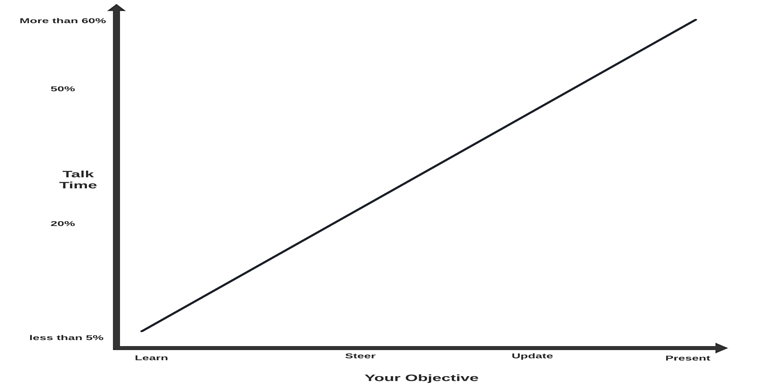TL;DR – Just look at the post image to help you talk the right amount in meetings.
We – humans – love to talk, that’s in our genes. That’s how humans evolved to become one of the most innovative life forms – by passing information between our tribes, our friends, and our children. One thing we have less though is the time!
It’s the most important currency for all of us and we get annoyed when we don’t use it properly such as binge-watching a show on Netflix or when someone else hijacks our time by inviting us to an “emergency” meeting. As you might all agree, meetings are the known villains in the corporate world, but no one can stop this supervillain (which I don’t think they all are, but that’s for another post). In fact, if you search on the web, you will find numerous stats about meetings – one such page says that nearly 55 million meetings are held per week in the US alone. 55 Million Meetings!
Despite the time sink these meetings cause, we forget about this annoyance as soon as we are in a meeting. We start talking immediately. We do love talking, don’t we? We talk about how smart we are, how time-pressed we are, and how important the work we are doing is. We talk about the weather, kids, pets, traffic, holidays, bad networks, and everything else under the sky.
Many experts started to notice this trend and recently, as a result of this, there has been a lot of focus on reducing the time we talk and increasing the time we listen. You would have heard one of the many quotes upon this idea such as ‘You have two ears and one mouth, so listen more and talk less.’ – all of which I agree with. There is a lot of value in listening; both from a getting work done perspective and from an empathetic perspective.
But, does that mean talking is all bad, especially in meetings? Yes and no! Let me explain!
Before I started writing this post, I was reflecting on the numerous meetings I have attended in the last few years. I was trying to see if I could come up with a way that people could use to categorize meetings and identify ones where we need to talk less, and the ones where we need to talk a bit more.
The idea here is not to oversimplify meetings but to provide a simple mental model to remind ourselves about our objective for the meeting. So in this blog, I present the l’Sup model!
You will see a simple graph below which visualizes this model. The fun meetings and social get-togethers don’t fall under any of these categories. Let there be no restrictions in those meetings provided you’re amongst your friends or family!

No alt text was provided for this image
In this model, I group the meetings into 4 broad categories:
- Learn meetings – Your objective is to learn from these meetings. You are there to learn about one of the following: a concept, project status, or a new skill.
- Steer meetings – Your objective is to give proper directions to your colleagues around a certain project or initiative. You are there to listen and provide steer with utmost clarity.
- Update meetings – Your objective is to provide updates on something you’re working on, and answer any questions. You will also need to capture any feedback coming out of these meetings.
- Present meetings – Your objective is to present a topic to a large set of audience – a keynote address can be a good example
On one end of the spectrum, we have the dark green learning meetings; on the other, we have the lighter green present meetings.
There is a reason why I used shades of green in the above line – to convey the point that talking is not all that bad.
For example, in an update meeting, you need to talk to ensure the sponsors and stakeholders are aware of what’s going on in your initiative. If you don’t do that, people will lose confidence in the initiative because they don’t know the latest updates and changes. At the same time, if you talk too much as a sponsor in an update meeting, you don’t give an opportunity for the project lead to give a proper status update. As a sponsor, this is a meeting where you have come to learn about the status. Now I hear you say, this is all complex.
I present you the l’Sup Model, see the blog post image, this is a simple line graph really. The X-axis tells you how much you should talk and Y-axis lists your objectives from those meetings. As you see, not all meetings will need stone-cold silence from you.
You can use this model as a compass to decide how long you want to talk in a meeting. The key thing is for you to decide your objective at least 5 minutes before the meeting. Here are some tips to make this model work for you.
Let’s say you’re someone who would like to express your thoughts, the minute you think about it. Have a notepad, write that thought down and wait!
If you are someone who doesn’t like to talk in meetings but have an update meeting. Plan ahead, prepare the slides, and pre-empt the questions.
Remember, if you’re in a learn meeting and you’re in a leadership position, prioritize the questions you ask. In my experience, this automatically reduces the time you talk.
You can also use the famous Bezos meeting rules too.
In summary, talking is not all that bad in meetings if it is inline with your objective for the meeting and you can use the l’Sup model as a compass for your meeting. This is just based on my experience observing meetings generally. You can use this as a mental heuristic to remind yourself about your meeting objective and talk time before the meeting.
Talk the right amount and prosper!


